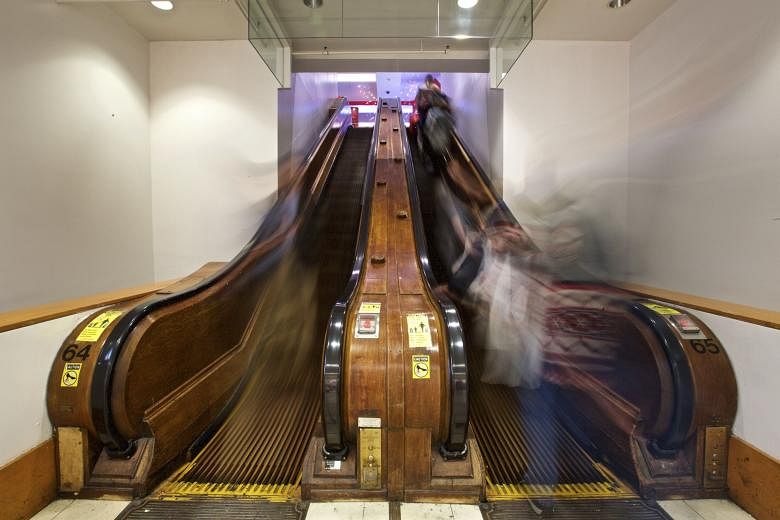NEW YORK • Here is what you could do in 1920s Manhattan that you cannot do today: Catch what is playing at the Roxy or who is playing at the Polo Grounds. Buy a pair of alligator shoes at Franklin Simon or see a pair of alligators at the Aquarium.
Here is something you can do: Ride the wooden escalators at Macy's.
Macy's is emerging from a US$400-million (S$563-million), four-year renovation that has brightened the flagship store in Herald Square. But the modernising impulse stopped at 20 Otis escalators of oak and ash that have trundled shoppers from one floor to the next for as long as 95 years.
"When I would tell people about the renovation," Mr Steven Derwoed, senior vice-president for store design and merchandising, said, "without exception, the first thing they'd say was, 'Please tell me you're keeping the wooden escalators.'"
But Mr Derwoed and Mr Alan Westenberger, director of facilities at Macy's Inc, said there was never really any question of replacing the escalators. "They're iconic to our brand," Mr Westenberger said. "At the end of the day, they operate effectively, they meet all the necessary codes and they're reliable."
Still, their survival seems nothing less than miraculous.
Between 1920 and 1930, as Macy's expanded towards Seventh Avenue and modernised its 1902 building, 40 Type L "Escalator" moving stairs - an Otis trademark at the time - were installed in the store. In the 1990s, 19 were modified with metal treads, keeping the oak side walls.
The unmodified escalators are distinguishable by the jumbo cleats on the step treads. They are about 1.3cm wide. The treads were milled from single pieces of ash. Ash is a hardwood often used for flooring.
Replacement cleats can be spotted by the presence of screw heads. But Mr Westenberger said some step treads in use today are original, as are the side walls and some mechanical parts.
But the big gaps between the cleats have long made the escalators dicey for anyone in high heels. Yellow "caution" stickers warn of the peril.
Signs also urge attention to children, who may run afoul of the long, tooth-like "comb plates" from which the cleats emerge and into which they disappear.
On July 2, 2010, four-year-old Maxlee Tejada dropped a water bottle on an escalator approaching the first floor. As he tried to grab it, his right pinkie was caught under a comb plate. A Macy's employee stopped the escalator, but the finger had been severed. An attempt to reattach it surgically proved unsuccessful.
Without commenting on this or other incidents, Macy's said in a statement: "To improve safety, we have added comb plate switches, skirt brushes and skirt switches. These... are enhancements to the original manufacturer safety devices."
Skirt brushes run along both sides of the escalator, at about ankle level, to gently keep body parts and objects away from the mechanism. Switches stop the machinery automatically in case of a sudden jolt.
As one of the few operators of wooden escalators in the world, Macy's has shared its expertise with Sydney Trains in Australia, which has wooden escalators at its Wynyard station and elsewhere.
"We're a small club," Mr Derwoed said.
NEW YORK TIMES

